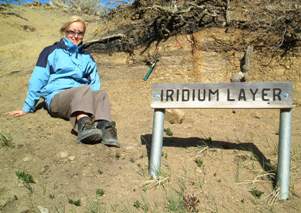 Geochemists have produced compelling evidence that further weakens the theory that dinosaurs perished in a “global wildfire” triggered by asteroid impact writes Dwain Eldred
Geochemists have produced compelling evidence that further weakens the theory that dinosaurs perished in a “global wildfire” triggered by asteroid impact writes Dwain Eldred
Geoscientist Online 16 March 2009 and Volume 19.4 April 2009
The popular theory of the dinosaurs’ fiery doom in a global wildfire developed from the occurrence of soot and chemicals at the supposed impact site, near Chicxulub in Mexico.
Doubt has now been cast on Chicxulub, by research suggesting that it is 300,000 years too old to have been the true end-Cretaceous impact site –
see Geoscientists passim. But whether you choose to believe the smoking-gun status of Chicxulub crater or not, the Cretaceous-Tertiary (K-T) boundary not only marks the final extinction of the dinosaurs, but it remains firmly associated with an asteroid impact because large quantities of the element iridium mark the boundary worldwide.
Scientists at Royal Holloway, University of London, had previously shown that no extensive charcoal was to be found in the impact layer - which one would have expected had there been widespread vegetation fires. In their latest research, the team has demonstrated from the nature and abundance of chemicals called pyrosynthetic Polycyclic Aromatic Hydrocarbons (pPAHs) throughout North America, that the combustion products were not the result of vegetation fires but by the vaporisation of oil source rocks.
While there is considerable evidence of wildfires in the vegetation from throughout the Cretaceous Period (as shown by the abundance of fossil charcoal in a range of rocks worldwide) Professor Andrew C Scott, one of the co-authors of the paper, said: “We have never found convincing evidence of the combustion products of large fires at the K-T level. While it is quite possible that there were some local fires - and indeed, these can occur at any time across the Earth - we do not see evidence of burnt soils, peat or any other evidence of erosion following the proposed global fire as one might expect”. “Instead the new chemical data provide compelling evidence that a significant volume of hydrocarbons were combusted during the K-T impact event” Scott told Geoscientist.
Co-author Dr Paul Finch said: “The occurrence of a unique K-T pyrolytic event is clearly shown by the abundance of pPAHs; but their chemical profiles are not consistent with the combustion of plant material. This and the pPAH distribution through the layers at different sites strongly support their generation at the impact site, rather than in secondary wildfires”.
While it is widely believed that at least one asteroid impact occurred near and at the end of the Cretaceous Period, many scientists believe that there may have been many other contributory causes of the mass extinction. Terrestrial and marine systems were already under stress from global cooling related to Deccan Trap volcanism. But whatever the explanation, says Scott: “our new data removes one of the more colourful explanations from the range of possible causes for dinosaur extinction”.
- Ref: Belcher, Claire M, Finch, Pail, Collinson, Margaret E, Scott, Andrew C, and Grassineau, Natalie V 2009: Geochemical evidence for combustion of hydrocarbons during K-T impact event. Proceedings of the National Academy of Sciences special feature, early online edition 23 February.